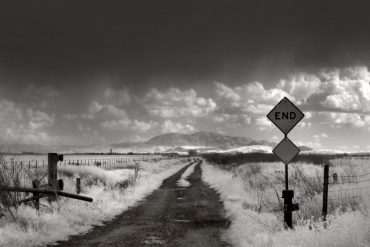This past June I celebrated my twenty‐fourth birthday. In the just over two decades I have been alive, humankind has accomplished truly incredible things. In the past twenty or so years we have seen the number of people living in extreme poverty cut in half. Human life expectancy has increased by 5.2 years. And the number of people contracting HIV/AIDS has and continue to drop sharply. We humans have created a vast global system of interconnected computer networks, successfully cloned animals, and launched the first unmanned terrestrial rover on Mars. When viewed in light of these accomplishments, I would say the past two decades of human history look rather impressive. Rosy, even. There is, however, another twenty‐year list of accomplishments accredited to humans that casts a far darker shadow. In approximately the time it takes to read this article, an area of Brazil’s rain forest larger than 200 football fields will have been destroyed. During the past few decades, close to twenty percent of the Amazon rain forest has been cut down, more than in all of the previous 450 years since European colonization began. Global temperatures have risen six‐ tenths of a degree in the same twenty years. Human population increased by 1.7 billion people, putting greater strain on the earth and her resources. Sea levels have risen three inches due in part to disappearing ice like that of Greenland and Antarctica, which to date have lost 4.9 trillion tons of ice. The list goes on.
The 21st Century Extinction Crisis
Humans have left a great impact upon the Earth over the past century than any other time in history, leading scientists to classify the current time period the Anthropocene. This proposed epoch began (roughly in the 1950s) when human activities started to have a significant global impact on Earth’s geology and ecosystems. One of the most shocking impacts of this human activity is one receiving less than front‐page media attention. According to leading research, the number of extinct species throughout the last century would have taken (depending on the vertebrate taxon) between 800 and 10,000 years to disappear. A study published in 2008 by the Center for Health and the Global Environment at Harvard Medical School says:
Although extinction is a natural phenomenon, it occurs at a natural “background” rate of about one to five species per year. Scientists estimate we’re now losing species at 1,000 to 10,000 times the background rate, with literally dozens going extinct every day.[ref]Chivian and Bernstein, eds., Sustaining Life.[/ref]
This high rate of species loss in the past century has been classified as the sixth in a previous list of five mass extinction events. Mass extinctions are defined as periods in earth’s history when abnormally large numbers of species die out simultaneously or within a limited time frame. To put this in perspective, two of these previous “Big Five” mass extinction events killed off 70 percent of all species existing on earth at the time. The current rate of species die‐off is comparable to such events of magnanimous devastation.
The Biggest Culprits: Habitat Loss and Climate Change
Unlike past mass extinctions, caused by events like asteroid strikes, volcanic eruptions, and natural climate shifts, the current crisis is almost entirely caused by us, humans. In fact, 99 percent of currently threatened species are at risk from anthropogenic activities, primarily those driving habitat loss, introduction of exotic species, and global warming.
Indonesia and Malaysia, nations with large tropical forests, are the dominant producers of palm oil on the world market today. Their forests are being cleared and burned daily to make room for new palm oil plantations. The Sumatran orangutan, elephant, and tiger, all of which are critically endangered, as well the endangered Bornean orangutans and pygmy elephants, are being driven toward extinction as their habitats are converted into massive oil palm plantations. National Geographic photographer Tim Laman traveled to Borneo in 2015 to document the raging fires consuming large parts of the country, set in‐part to clear already deforested land for palm planting and exacerbated by record‐breaking drought. The images he produced showcased the horrors of unsuitable land development. Thousands of acres of scorched earth, farmers beating back flames with little more than t‐shirts and water buckets, and most heartbreaking of all, Bornean orangutans high in smoke‐shrouded trees trying to escape the encroaching inferno. Conservationists worked tirelessly to relocate orangutans when able, but there is little to no doubt that lives of this critically endangered primate were claimed by such “machines of progress.” Climate change has contributed significantly to the numbers of endangered or now‐extinct species. Temperature in the Arctic has increased at twice the rate of the rest of the globe, and the region is expected to increase an additional 8° C (14° F) by the close of the twenty‐first century. Satellite data indicates that since the late 1970s Arctic sea ice has decreased by about 12 percent per decade. What’s especially alarming is the decrease in multi‐year ice. As the percentage of perennial ice dwindles, the greater likelihood arctic ice obligates (such as the polar bear, walrus and harp seal) will dwindle as well. Scientists are already noting an increase in polar bear starvation deaths, most likely attributed to lack of sea ice hunting grounds. No sea ice, no seals to hunt on the ice, no polar bears. End of story. Because the rate of change in our biosphere is increasing, and because every species’ extinction potentially leads to the extinction of others bound to that species in a complex ecological web, numbers of extinctions are likely to snowball in the coming decades as ecosystems unravel.
What Can Be Done?
So, what do we do with all of this? How can a problem that seems so large, covers such an array of species across all continents and appears almost insurmountable be tackled? To be honest, no one really knows how many species are in danger of becoming extinct, or have become so already. The numbers are too great, and the afflicted areas too vast to canvas properly. However, in the face of so much loss, actions can still be taken to turn the tide. While much concern over extinction focuses on globally lost species, most of biodiversity’s benefits take place at a local level. That means taking action for imperiled species in our own back yards is the first step toward combating the larger issue of worldwide species extinction. There are very practical ways to take actions towards protecting local species, which will, with enough participation, end up benefiting species globally. For instance, Anthony D. Barnosky, a Professor in the Department of Integrative Biology at the University of California, Berkeley, suggests ten ways everyone can help stop the sixth mass extinction.
Extinction is not a problem that will be solved overnight. It has taken decades, even centuries, to bring us to the crisis point we are now at. And so, we must prepare ourselves for the long work of restoration ahead. So that in the next twenty years we are enjoying the company of more, not less, of God’s creatures.
Bibliography
Benton, Michael J. When Life Nearly Died: The Greatest Mass Extinction of All Time, Revised edition. Thames & Hudson, 2015.
Chivian, Eric and Aaron Bernstein, eds. Sustaining Life: How Human Health Depends on Biodiversity, III edition. Oxford University Press, 2008.
Ten Ideas to Help End Extinction
1. Spread the word, to your family, friends, co‐workers, and social media circle: the extinction crisis is real. 2. Reduce your carbon footprint. 3. Buy products from companies committed to using sustainably produced palm oil in their products. 4. Eat fish from only healthy fisheries. 5. Eat less meat. 6. Never, ever buy anything made from ivory—or from any other product derived from threatened species. 7. Enjoy nature. 8. Adopt a species or become a citizen scientist. 9. Vote for and support leaders who recognize the importance of switching from a fossil‐fuel energy system to a carbon‐neutral one, who see the necessity of growing crops more efficiently, whose economic agenda includes valuing nature, and who promote women’s rights to education and healthcare. 10. Don’t give up!
This list was adapted from Anthony D. Barnosky originally published on the Huffington Post Blog. For the full picture we recommend reading Anthony D. Barnosky, Dodging Extinction: Power, Food, Money, and the Future of Life on Earth (University of California Press, 2014).





